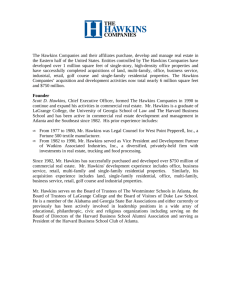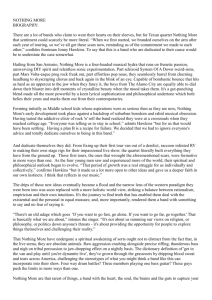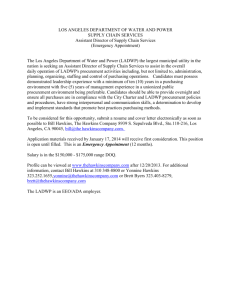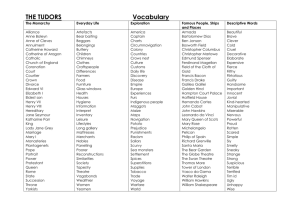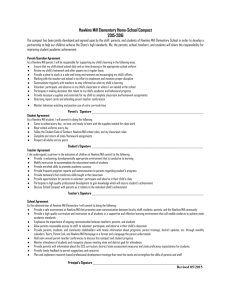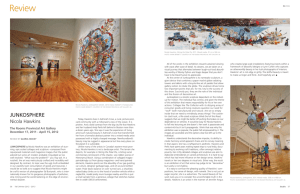Kauffman case study 1
advertisement
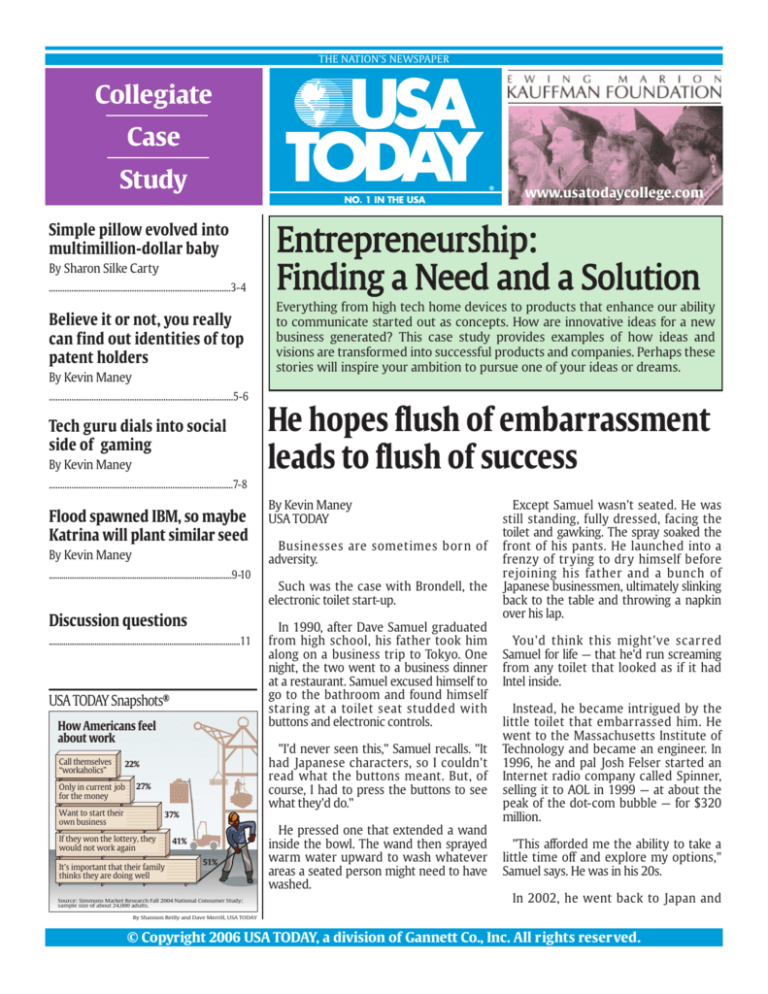
THE NATION’S NEWSPAPER Collegiate Case Study www.usatodaycollege.com Simple pillow evolved into multimillion-dollar baby By Sharon Silke Carty .................................................................................3-4 Believe it or not, you really can find out identities of top patent holders By Kevin Maney Entrepreneurship: Finding a Need and a Solution Everything from high tech home devices to products that enhance our ability to communicate started out as concepts. How are innovative ideas for a new business generated? This case study provides examples of how ideas and visions are transformed into successful products and companies. Perhaps these stories will inspire your ambition to pursue one of your ideas or dreams. ..................................................................................5-6 Tech guru dials into social side of gaming By Kevin Maney He hopes flush of embarrassment leads to flush of success ..................................................................................7-8 Flood spawned IBM, so maybe Katrina will plant similar seed By Kevin Maney ........................................................................................9-10 Discussion questions ............................................................................................11 USA TODAY Snapshots® How Americans feel about work Call themselves “workaholics” 27% Want to start their own business Businesses are sometimes born of adversity. Such was the case with Brondell, the electronic toilet start-up. In 1990, after Dave Samuel graduated from high school, his father took him along on a business trip to Tokyo. One night, the two went to a business dinner at a restaurant. Samuel excused himself to go to the bathroom and found himself staring at a toilet seat studded with buttons and electronic controls. "I'd never seen this," Samuel recalls. "It had Japanese characters, so I couldn't read what the buttons meant. But, of course, I had to press the buttons to see what they'd do." 22% Only in current job for the money By Kevin Maney USA TODAY 37% If they won the lottery, they would not work again It’s important that their family thinks they are doing well 41% 51% Source: Simmons Market Research Fall 2004 National Consumer Study; sample size of about 24,000 adults. He pressed one that extended a wand inside the bowl. The wand then sprayed warm water upward to wash whatever areas a seated person might need to have washed. Except Samuel wasn't seated. He was still standing, fully dressed, facing the toilet and gawking. The spray soaked the front of his pants. He launched into a frenzy of trying to dry himself before rejoining his father and a bunch of Japanese businessmen, ultimately slinking back to the table and throwing a napkin over his lap. You'd think this might've scarred Samuel for life — that he'd run screaming from any toilet that looked as if it had Intel inside. Instead, he became intrigued by the little toilet that embarrassed him. He went to the Massachusetts Institute of Technology and became an engineer. In 1996, he and pal Josh Felser started an Internet radio company called Spinner, selling it to AOL in 1999 — at about the peak of the dot-com bubble — for $320 million. "This afforded me the ability to take a little time off and explore my options," Samuel says. He was in his 20s. In 2002, he went back to Japan and By Shannon Reilly and Dave Merrill, USA TODAY © Copyright 2006 USA TODAY, a division of Gannett Co., Inc. All rights reser ved. AS SEEN IN USA TODAY’S MONEY SECTION, WEDNESDAY, NOVEMBER 23, 2005 Doug and Julie on Days of Our Lives for the past 30 years. stayed at a Hyatt. Every bathroom had an electronic toilet. He did some research and found that in Japan, most business hotels, many public restrooms and just about every high-income household had an electronic toilet. Maybe Samuel is right and it really is the right time for electronic toilets in the USA. It seems that Americans who try electronic toilets absolutely love them. "I believed it was time to introduce this to America," Samuel says. "I thought it was a joke when I installed it," says James Hong, founder of website Hot or Not. "I had no idea I would like it so much. When I travel, I often think in the hotel bathroom how much I wish I had the Brondell there." So he started a company, naming it after J.F. Brondel, who — according to the Sulabh International Museum of Toilets, which I swear I did not make up — invented the valve-type flush toilet in 1738. Samuel added a second "l" to make the company name Brondell. "It was a stronger name," Samuel says. Samuel is an ambitious guy, to say the least. Around this same time, Felser came back from Burning Man, an arts festival in the desert that attracts a lot of techies who run around naked there. Felser had taken tons of digital photos, and his friends really wanted to see them. Who wouldn't? Felser figured out an interesting way to do this: create the equivalent of a virtual private network among a group of friends over the Internet, so they could easily see each other's large files such as photos, music or video. Felser and Samuel thought other people would buy the technology. It became the basis for Grouper, a company Samuel and Felser started that has so far had moderate success. In December, Grouper will launch a major push into video sharing — kind of a video Flickr. Samuel is busy as both president of Grouper and chairman of Brondell. (Felser is not part of Brondell.) Brondell started selling its toilets in January. The high-end model, the Swash 600, costs about $500. It has a heated seat, computer-chip smarts, touch-pad controls and — yes — a wand that sprays you clean. Just make sure you're sitting. A little dryer follows with warm air. Then there is the ultimate endorsement: Google has electronic toilets — though not Brondell's — in the restrooms at its headquarters. Brondell Brondell founder: Dave Samuel with the Swash electronic toilet. Now, here's the problem: Americans have so far failed to buy into the idea of having their private parts go through the equivalent of a mini car wash. A competing company, Toto, has been selling an electronic toilet for a while now with only modest results. Marketing is a challenge. There aren't a lot of good options for getting people to try it. Do you set up a demo unit at Home Depot? Ads have to walk a thin line. Maybe the company needs to hire a spokesman like Bob Dole and come up with a euphemism as sterile as "erectile dysfunction." Brondell made a threeminute infomercial that's full of normallooking people earnestly saying things like, "We're perfectly satisfied and perfectly clean all day long." By the way, the older couple in the infomercial is Samuel's grandparents, Bill Hayes and Susan Seaforth Hayes — aka Businesses will do anything to get a little piece of that Google magic. I can see management consultants coming into companies and saying, "What's with this toilet paper in the restrooms? Get rid of it. Get electronic toilets. Google doesn't use toilet paper. From now on, you don't use toilet paper." Could ignite a craze, as when managers star ted firing the bottom 5% of performers because Jack Welch did it at General Electric. "I liken it to TiVo," Samuel says, drawing a parallel between electronic toilets and a video machine that ignites viewer passion. "Once you experience pausing television, there's no going back. Once you experience sitting on a warm toilet and having a warm water wash, there's no going back." Samuel looks at the opportunity like a technologist. He notes that toilets have not changed in the 250 years since Brondell's invention. "It's one of the few areas that has seen little technological improvement," he says. "We're excited about changing that." It's early yet, but it will be interesting to see if he can Reprinted with permission. All rights reser ved. Page 2 AS SEEN IN USA TODAY’S MONEY SECTION, MONDAY, JANUARY 9, 2006 Simple pillow evolved into multimillion-dollar baby Boppy’s creator played it smart from the start feeding, a job that can be taxing on exhausted new moms' backs, arms and other areas. By Sharon Silke Carty USA TODAY GOLDEN, Colo — If you've given birth or adopted in the past 10 years, chances are you know what a Boppy is. And more important, how to use it. If you haven't, well, read on. Because this is the story of a woman who came up with one of those "Why didn't I think of that?" ideas -- a simple pillow stuffed with foam -- and turned it into a multimillion-dollar business. She now has the No.1 baby product in the country, according to American Baby magazine. Susan Brown had already decided she was going to quit her day job when she invented the Boppy, almost accidentally. Her daughter's day care center asked parents to bring in pillows to prop up infants who couldn't sit up on their own. Brown came up with a C-shaped pillow in one night. Seventeen years later, the basic design hasn't changed. "It's just the perfect pillow for just about ever ything," says Judy Nolte, editor of American Baby, whose readers have named Boppy the most invaluable product for new moms four consecutive years. "I think that mothers are very wise to select it as their favorite product. It fills a need that nobody realized was there." In fact, Boppy's fans love it because it does a job it never was intended for: It helps suppor t babies while breast- "Now it's almost embarrassing to admit, but when people started using it for breast-feeding, I was like, 'Oh, yeah. Of course,'" Brown, 51, says. Brown, who lives in Golden, a suburb of Denver, had dreamed of opening her own business since she was a child. She would write up mini-business plans, only to talk herself out of the idea by proving how the business would not work or was overly ambitious. She began a career in advertising sales but still daydreamed about opening her own business. Then, while on maternity leave with her second child, she found out that she had been passed up for a promotion. She decided it was time to go but stuck around until she was fully vested in the company's profit-sharing plan. With $25,000 from the profit-sharing and $7,000 from an investor, Brown took Boppy to a children's clothing trade show in New York in 1991 and sold it to about 50 children's stores. Within the first year, she finagled a spot in One Step Ahead, a catalog that has launched many baby products into the mainstream. But money quickly ran out. So Brown applied for and got a loan from the nonprofit Colorado Enterprise Fund. She says she needed money to take Boppy to the International Juvenile Products Show in Dallas. Without the loan, the company would have failed. About Susan Brown Title: CEO of Boppy Co. Age: 51. Family: Husband, Roger; children Austin and Alistair; stepchildren Abi, Molly and Max. Hobbies: Hiking, singing show tunes, gardening. Favorite movies: Dumb and Dumber, Days of Heaven. Favorite book: The Woman in White by Wilkie Collins. First job out of college: Freelance writer for the Children's Television Workshop writing Spidey Super Stories. Ceyl Prinster, executive director of the fund, remembers being struck by how down-to-earth Brown is. Prinster says she trusted that Brown's ability to think both creatively and analytically would help propel Boppy to greater heights. "A lot of entrepreneurs are very idealistic and think they can keep going on vision alone," Prinster says. "She had a good idea of what it would take to get this product to the next level." Now, the privately held Boppy Co., Reprinted with permission. All rights reser ved. Page 3 AS SEEN IN USA TODAY’S MONEY SECTION, MONDAY, JANUARY 9, 2006 known until recently as Camp Kazoo, has annual sales of $15 million to $25 million through such retailers as Babies R Us, Pottery Barn Kids and Burlington Coat Factory. Brown says WalMart has approached her about selling the product in its stores, but she wants to keep a more upscale feel to it and is trying to resist selling the $25 to $35 pillows at bargain prices. Prinster says one of Brown's strengths is "being able to know where her weaknesses are, and shoring that up with other people." She also has solicited advice from people who have been through the business-development process. "The most common piece of advice you get is to diversify," Brown says. "That advice isn't always good." To diversify, the company started selling TransferMations, an iron-on stencil that would allow parents to paint murals on nursery walls by simply coloring between the lines. Parents liked it, but it became a logistical mess. The company was suddenly dealing with an entirely new distribution chain, selling to craft stores rather than to baby-product retailers. And customers began asking if the company was going to start selling paint to go along with the patterns, which would have posed a new set of problems. Brown also is dabbling in the advice business herself. She's self-published a book, Start Your Own Baby Products Business, in which she advises prospective entrepreneurs to focus and resist the urge to underprice. The book is dotted with pictures of happy moms, dads and babies with their Boppies. Pat Edson, a consultant who sits on the Boppy board, says Brown "has zero ego, and that is just a beautiful thing to see in today's world. That gives her a competitive advantage. ... Her lack of ego allows her to surround herself with really strong thinkers and makes sure she gets the best information." Brown says one of her weaknesses is picking fabrics: "It seems like every one I like sells poorly." So Brown listens to her creative director, advisers and customers. The company's newest materials include soft pastel velvet, gingham and vintage alphabet patterns. While Brown has developed a loyal following for her product, she's also developed a loyal following among her employees. At Boppy, 20 of 23 employees are women, and more than half are moms. Brown gives them flexibility to work when their children are in school, skipping lunch to make the day shorter. A room in the colorful office space is set aside for mothers to nurse or pump breast milk during their day. "When I look back, that energy may have been much better spent on the core product," Brown says. "You have to analyze the advice you get." "The people who work with her and around her are brutally loyal," Edson says. "That helps her retain talent and helps her attract high talent as well." Boppy now has expanded its product line by making other kinds of pillows, ones that have toys attached that babies can play with and others that help pregnant moms sleep and sit more comfortably. Creating an office that people love to come to was one of Brown's goals. The company is in the early stages of licensing the Boppy brand name to other products, such as baby clothes or toys. "No matter how hard I am working, I can still go to soccer," Brown says. "That made my life so much more livable. I've gotten so much outside validation that this is the kind of place people want to be." Reprinted with permission. All rights reser ved. Page 4 AS SEEN IN USA TODAY’S MONEY SECTION, WEDNESDAY, DECEMBER 14, 2005 Believe it or not, you really can find out identities of top patent holders Ah, patents. The topic has pretty much taken charge of my life since last week's column revealing the lack of any way to identify the top 10 living U.S. patent holders. Apparently half the Ear th's population has something to say about patents, and most of them are e-mailing me. My inbox has been blowing up like Anna Nicole Smith between diets. seems like a throwback to the likes of Dick Van Dyke's Caractacus Potts in Chitty Chitty Bang Bang. Spector churns out all sorts of oddities, such as the Porto Auto Oil Easy Drain and a motorized pot-washing tool. Back in 1979, Spector apparently caused quite a stir by patenting a board game with the title "puck projecting game." Some people thought he'd patented hockey. 5. Gurtej Sandhu, Boise, 576. But the deluge has its upsides. The column 6. Warren Farnworth, Boise, 547. prompted a few patent database companies to take a whack at the question. Two — ipIQ of Chicago and 7. Salman Akram, Boise, 527. 1790 Analytics of New Jersey — came up with By Kevin Maney answers. All three work for Micron Technology in that great mecca of So here, for the first time, is a list of the 10 most-prolific American invention, Idaho. "It is rather incredible," says Tony Breitzman of 1790 Analytics. "As a rule, other than Akram and inventors. This is from ipIQ: Farnworth (who have a lot of co-patents), there is not much 1. Shunpei Yamazaki, Japan, 1,432 patents. Yes, it seems to be duplication." true: The top individual holder of U.S. patents is based at Tokyo Micron is the last surviving U.S. maker of DRAM chips, which tech research firm Semiconductor Energy Laboratory. For decades, the popular assumption has been that Thomas Edison are important in just about every electronic device. is the all-time patent king with 1,093 patents. Yamazaki blows But why Micron, with its $600 million annual R&D budget? away Edison, and he is still inventing and getting patents. IBM and Microsoft spend 10 times that on research. Micron 2. Donald Weder, Highland, Ill., 1,322. This is the guy who has CEO Steve Appleton brought up a couple of reasons. One is that invented dozens of ways to make flower pots, dozens of ways in its hypercompetitive industry, Micron has to have the to bundle flowers, and a whole lot of other things that have to protection of lots of patents to survive, so "The culture of the do with florists. When ipIQ sent me its results, Weder showed company recognizes and rewards innovation," he says. But a lot 1,321 patents — but he got another one Tuesday. The title: of tech companies could say that. "Apparatus for forming and securing a decorative pleated cover So maybe it helps that at Micron, the patent attorneys' offices about a flower pot." are right in the labs so they can work with the researchers to 3. Kia Silverbrook, Sydney, 801. When Australia's patent nail down patents right out of the box. agency marked its centenary in 2004, it celebrated great 8. Mark Gardner, Cedar Creek, Texas, 512. Gardner works for Australian inventions — such as vegemite. The country isn't much known for invention. On the U.S. Patent and Trademark AMD, Intel's peskiest competitor. You can find his patents deep Office's 1997 list, no Australian appeared in the top 100. The inside AMD's microprocessors. His most recent patent, in June, secretive Silverbrook, though, runs Silverbrook Research, and was titled, "Ultrathin high-K gate dielectric with favorable he has zoomed to No. 3 with inventions such as a tiny ink-jet interface properties for improved semiconductor device performance." I think I'm going to ask for one for Christmas. printer that can fit in a mobile phone. 4. George Spector, New York, 723. Hey, here's a guy who really did invent a better mousetrap! It's patent No. 5,528,853, "Magnetic computerized mouse trap," issued in 1996. Spector 9. Heinze Focke, Verden, Germany, 508. Focke's patents mostly center on packaging — both on types of packages and processes for packaging assembly lines. Reprinted with permission. All rights reser ved. Page 5 AS SEEN IN USA TODAY’S MONEY SECTION, WEDNESDAY, DECEMBER 14, 2005 10. Joseph Straeter, Highland, Ill., 477. Once again, we're back to flowers. Like a hockey player lucky enough to skate on Wayne Gretzky's line, you can pick up a lot of points just by being there. Straeter works for No. 2 patent holder Weder, and most of Straeter's patents are shared with Weder. Now, 1790 Analytics came up with basically the same list, but it also ran a different version that separated out utility patents from design patents. The latter are more about changing the appearance of an existing invention. If you do that, the names on the list stay the same, except Straeter drops off — replaced, remarkably, by yet another Micron researcher, Leonard Forbes. What else have I gleaned from the patent e-mail onslaught? Well, I got an e-mail from Esther Takeuchi, who works on battery research for Greatbatch, a maker of power sources for a lot of medical devices. She says that she's been told she has more patents — 126 — than any other living woman and wonders if it's true. From the lists I've seen and from poking around the USPTO's database, it seems likely that she is indeed the most-prolific female inventor. And then there's one other oddity, pointed out by reader Michael Ravnitzky. This would be the Invention Secrecy Act of 1951. It's possible that any patent list results are skewed because various government agencies have the ability to classify any patent as secret and make it invisible to the public. The USPTO even keeps a chart of "invention secrecy activity." It shows that so far in 2005, there have been 106 "new secrecy orders imposed." There are 4,915 "total secrecy orders in effect." So if among all those florist patents Weder and Straeter invented the quantum computing secret decoder ring, we'd never know about it. Reprinted with permission. All rights reser ved. Page 6 AS SEEN IN USA TODAY’S MONEY SECTION, MONDAY, DECEMBER 12, 2005 Tech guru dials into social side of gaming Digital Chocolate founder also created Electronic Arts By Kevin Maney USA TODAY About a year ago, Trip Hawkins had an epiphany — and not the kind you'd expect from a legendar y Silicon Valley entrepreneur. "I realized I had been doing the wrong thing for 30 years," he says in his office, eyes twinkling behind rimless glasses, his tanned skin and swept-back gray hair making him look like a displaced movie star. That is why Hawkins is sure he's doing the right thing now with his 2-year-old company, cellphone-game-maker Digital Chocolate. Hawkins had spent those previous years chasing what he calls fidelity, or realism. In 1982, he started one of Silicon Valley's all-time great successes: Electronic Arts, the world's biggest video game company. At EA, Hawkins is best known for creating Madden NFL Football. His goal inside EA was to use technology to make the most realistic games possible. He was out to push the fidelity envelope, thinking that's what consumers craved. the market. 3DO hung around as a game maker but never took off, eventually filing for Chapter 11 bankruptcy protection in 2003. Hawkins started to feel that something about video games was lacking. Madden Football might be astoundingly realistic, yet it's played by only about 5% of the people who watch the Super Bowl, Hawkins says. Participants in fantasy leagues -- a very low-fidelity activity based on statistics from real football games -- outnumber video game football players 3 to 1. Hawkins' friends describe him as philosophical yet pragmatic. "He'll build an idea of how technology will affect the world and try to get out front of the wave before it forms," says Dave Evans, a tech consultant who's known Hawkins for more than 25 years. So, Hawkins spent time thinking about what people need, not just want. As we become more mobile, "There's a loneliness we feel in our society," Hawkins says. "We want to grab onto what we've lost." And that's connection and community. People want to go to Super Bowl parties or interact while playing fantasy football, Hawkins concludes. Fidelity is important to an elite segment of the market, but social connection is important to just about everyone. "I took the wrong branch," he says. "I thought it was all about fidelity, but what people want is the social aspect." That's Hawkins' epiphany: If you're going to make games, make them social and mobile. "Eventually the industry will have to go more in (Hawkins’) direction. It’s the best future for mobile gaming. — Carrie Couskos, editor for GameSpot In 1991, Hawkins left EA because he saw the digital CD opening a path to yet higher fidelity. He started 3DO and built technology that was a forefather of Sony's PlayStation. But Hawkins was too far ahead with 3DO. The game box fizzled on It's about desire Hawkins keeps the lights off in his modest corner office and lets the sunlight stream through the windows. On a ledge are chocolate bars with labels that say Digital Chocolate. Hawkins came up with the name because he wants to create the same desire for his games that people have for chocolate. On his desk is a PC, an old-style hard briefcase and a photo of his four kids on a couch playing video games. He pulls out a cellphone to show off the company's latest games. One is called MLSN Sports Picks (MLSN stands for Mobile League Sports Network). It's something of an online game show about sports. You create a league with a group of friends, who all can play at different times on their cellphones For more educational resources, visit http://education.usatoday.com Reprinted with permission. All rights reser ved. Page 7 AS SEEN IN USA TODAY’S MONEY SECTION, MONDAY, DECEMBER 12, 2005 anywhere in the world. You answer questions to predict outcomes in upcoming sports events. The system keeps score and ranks you against your friends. Another new game, AvaFlirting, lets users create characters who go out on the network and try to date characters created by other people. Depending on their success, characters climb popularity rankings. Neither game tries to use all of a cellphone's processing power. The graphics are minimal. The allure is in the social connection, Hawkins says, not the on-screen experience. Though few reviews are out yet for the newer games, Digital Chocolate is generally winning raves. "They're doing a ver y good job of working within the confines of the platform," says Carrie Gouskos, an editor at respected gaming website GameSpot. She notes that some of Digital Chocolate's earlier games have gotten some of GameSpot's highest ratings ever for mobile games. Digital Chocolate already sells dozens of games, from WordKing Poker to Sumo Smash. Some are graphics-rich, singleplayer games. But since Hawkins' epiphany, he has pushed Digital Chocolate to make MLSN-type social games. Just about every other mobile game company is trying to re-create video game titles such as Tiger Woods PGA Tour or Harry Potter games so they look and play much like a PlayStation or Xbox game. Some wireless industry developments suggest those attempts are mistaken. For About Trip Hawkins Born: Dec. 28, 1953. Age: 51. Education: Harvard, designed his own major in strategy and applied game theory; MBA, Stanford. First major position: Director of strategy and marketing, Apple Computer, early 1980s. Companies founded: Electronic Arts, 1982; 3DO, 1991; Digital Chocolate, 2003. Awards: Inducted this year into the Academy of Interactive Arts & Sciences Hall of Fame. Family: Wife, Lisa; four children. instance, Nokia in November said it was giving up on its N-Gage phone, which tried to be a combination phone and high-fidelity video game machine. Few were sold. Still, conventional wisdom puts Hawkins in the minority, fighting upstream — just like the early days of 3DO. A big, early bet Hawkins launched Digital Chocolate in 2003 with his own money and one other investor: Bob Pittman, founder of MTV and later an executive at AOL. In 2004, the company raised an additional $13 million, largely from four venture-capital firms. The mobile games industr y has momentum. Mobile gaming will grow sixfold from 2004 to $8 billion in 2008, says research firm Strategy Analytics. In 2006, nearly 1 billion cellphones will be sold, almost all with gaming capability, say analysts. Meanwhile, venture capital is flowing into mobile game companies, which now number more than 200. In November, Microsoft said it plans a major push into mobile games in 2006. In this nascent segment, Digital Chocolate ranks in the top 10 gamemakers, according to research firm M:Metrics. The company has sold about 8 million of its early games. Prices vary, but subscription games can cost $2.99 a month. Yet Hawkins' big bet is on the low-fi social games, and that's just beginning. MLSN only launched on Cingular and Sprint Nextel subsidiary Boost Mobile this fall. This month, MLSN will launch on Verizon and Sprint. AvaFlirting and a sibling game, AvaCars, won't come out until 2006. Clearly, Hawkins isn't out to run a middling mobile games company. He's out to change the industry and create games with Super-Bowl-size audiences - and prove he's right where for years he'd been wrong. "Trip is a ver y opinionated, ver y teachable guy," says pal Evans. "He's totally about the better idea. The way he's going with Digital Chocolate is a good example of his teachability." "Eventually, the industry will have to go more in (Hawkins') direction," says GameSpot's Gouskos. "It's the best future for mobile gaming." The next few years will show whether Hawkins' epiphany pays off. Reprinted with permission. All rights reser ved. Page 8 AS SEEN IN USA TODAY’S MONEY SECTION, WEDNESDAY, SEPTEMBER 14, 2005 Flood spawned IBM, so maybe Katrina will plant similar seed By Kevin Maney USA TODAY Hard to imagine that a flood like the one in New Orleans could possibly result in anything good. Yet in one of those odd twists of history, a 1913 flood that devastated Dayton, Ohio, had a huge impact on the technology industry. If not for that flood — still among the worst in the USA — there would have been no IBM. Which would have meant no System/360 in the 1960s, no "THINK," no legendary salesmen in white shirts, no IBM PC. And if there had been no IBM PC, then Microsoft might today be a quaint little specialized software company and Intel a struggling maker of memory chips. Michael Dell might be a salesman for Unisys. All because the Dayton flood kept Thomas Watson Sr., who built IBM, from going to jail. The story starts with National Cash Register, which had its headquarters on high ground in Dayton. NCR was run by short, wily, ornery John Patterson, whose monopolistic practices might make Bill Gates cringe. Patterson trained salesmen to break a competitor's cash register when a shopkeeper wasn't looking, then explain that NCR's machines were more reliable. Watson started as an NCR salesman in the 1890s, working his way up to become chief marketing officer and Patterson's protege. (This is all from research I did for my book about Watson, The Maverick and His Machine.) At the turn of the century, NCR controlled the market for cash registers, which were the hottest business management technology of the day. Photo courtesy of National Oceanic and Atmospheric Administration 1913: Men pull a boat after Dayton, Ohio, flooded. IBM founder Thomas Watson Sr. and his mentor, John Patterson, emerged as heroes. jail, pending appeal. About a month later, all-day rain soaked Ohio. On March25, the rivers that converge at Dayton started swelling. At 6:45 a.m., Patterson gathered a group of executives — minus Watson — on NCR's roof, where they could see that a flood looked inevitable. Patterson told the executives to start collecting food, water, blankets and medicine and ordered the woodworking department to drop everything and make flat-bottomed boats. Believing NCR would stay dry on its hill, Patterson decided to turn his campus into the equivalent of the Superdome. He opened it to anyone who needed shelter. But by 1912, the Taft administration was on an antitrust tear. It had gone after Standard Oil. Then the administration took aim at NCR, indicting Patterson, Watson and 28 other NCR executives under a rarely used statute for criminal antitrust. At 8:30 a.m., one of the city's levees broke. Waves of water raced through town, sucking in horses and wagons and furniture. Like in New Orleans, the water reached rooftops. Unlike in New Orleans, there was no sewer system, so the flood carried away every outhouse and its contents. NCR got creamed in court. A guilty verdict was reached on Feb. 13, 1913, and each NCR official faced up to three years in Residents scampered to safety at NCR, where a couple thousand took refuge. In the boats they made, NCR employees Reprinted with permission. All rights reser ved. Page 9 AS SEEN IN USA TODAY’S MONEY SECTION, WEDNESDAY, SEPTEMBER 14, 2005 plucked others from trees and roofs. Watson was in New York on business. In NCR's archives are a series of telegrams between Watson and Patterson as Watson swung into action to send help to Dayton. "Am arranging for relief train. Wire what you need most," Watson wrote in one. In two days, Watson pulled together donations and sent two trains packed with food, water, tents — and newspaper reporters. The reporters were key. While NCR's acts were sincere, Patterson also sensed an opportunity. The Dayton flood made worldwide headlines. So, too, did NCR's heroics. The Chicago Evening Post wrote: "Patterson was revered by Dayton people before the catastrophe but is now an idol for whom thousands would lay down their lives." But this worked out pretty well for Watson Sr. In May 1914, he took a job running a wheezing little agglomeration of assets called Computing-Tabulating-Recording Co., or C-T-R. Almost a year later, an appeals court set aside NCR's antitrust verdict and granted a new trial. Unwilling to retry the flood heroes, Woodrow Wilson's administration dropped the case. Over the next decade, Watson focused C-T-R on information processing and in 1924 renamed it the ambitious-sounding International Business Machines. During the boom of the late 1920s, IBM was essentially like Cisco Systems during the dotcom bubble — a young company with a sizzling stock and important new technology that hardly anyone understood. IBM — entirely built in Watson's image — grew like crazy through the Depression. Watson became as famous as Gates or Steve Jobs today. And IBM just kept growing. It was one of the great public relations turnarounds of all time — from convicted business demon to media darling. And you thought only Martha Stewart could do that. The Dayton flood made that possible, though of course no one could've seen that at the time. Then, in the fall of 1913, Patterson bizarrely pushed almost every convicted executive out of NCR, including Watson. Imagine how Watson must have felt: He was 40, was driven away by his mentor, had a jail term hanging over his head — and his wife was pregnant with their first child, who would become IBM's other famous CEO, Thomas Watson Jr. So it's fascinating to wonder if some seed is being planted amid Katrina's mess. It's not much consolation for the lives and homes lost, but maybe a career is being shaped or an idea formed that wouldn't have been possible had the disaster not happened. And maybe that person or concept will later emerge to create something great. It's a small flicker of solace. Reprinted with permission. All rights reser ved. Page 10 DISCUSSION QUESTIONS ADDITIONAL RESOURCES 1. What factors make the difference between a creative idea that becomes a successful company and an idea that never moves forward? Ewing Marion Kauffman Foundation www.emkf.org 2. What determines if an entrepreneurial venture stays in business or is sold for a profit, or starts but never becomes successful? Sole Proprietor Magazine www.soleproprietormagazine.com 3. Who or what inspires a new entrepreneur most (e.g., family role model, access to investment dollars, a curious and creative mind, knowing the right people)? Explain your reasoning. 4. What state laws or procedures do you need to adhere to when starting a new business in the state where you currently live? What are the differences among a sole proprietorship, a limited partnership and a corporation? What laws and requirements apply to each type of business organization? Compare and contrast the benefits and drawbacks of each type of business. Which would you choose? Why? Small Business Administration www.sba.gov US Department of Labor www.dol.gov FUTURE IMPLICATIONS 1. Read several features in USA TODAY’s Money section about new entrepreneurs and successful business leaders. What can you learn from their experiences that would enhance your ability to start your own business? How did they learn from the successes and failures? 2. What state and federal laws and funding sources encourage entrepreneurs to develop and launch new businesses? How could the laws be changed to encourage new entrepreneurs even more so? 3. Which of your strengths and abilities would make you a successful entrepreneur? What knowledge or skills do you lack that you need to develop? Notes: © Copyright 2006 USA TODAY, a division of Gannett Co. Inc. All rights reser ved. Page 11
